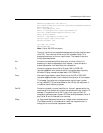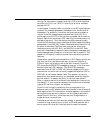
Understanding the SIP Protocol
November 2009 249
INVITE sip:b@biloxi.com SIP/2.0
Via: SIP/2.0/UDP pc33.atlanta.com;branch=z9hG4bK776asdhds
Max-Forwards: 70
To: b <sip:b@biloxi.com>
From: A <sip:a@atlanta.com>;tag=1928301774
Call-ID: a84b4c76e66710@pc33.atlanta.com
CSeq: 314159 INVITE
Contact: <sip:a@pc33.atlanta.com>
Content-Type: application/sdp
Content-Length: 142
(A's SDP not shown)
INVITE Message
Note: Caller A's SDP not shown
The first line of the text-encoded message contains the method name
(INVITE). The lines that follow are a list of header fields. This
example contains a minimum required set. The header fields are
briefly described below:
Via Contains the address (pc33.atlanta.com) at which Caller A is
expecting to receive responses to this request. It also contains a
branch parameter that identifies this transaction.
To Contains a display name (Caller B) and a SIP or SIPS URI
(sip:callerb@biloxi.com) towards which the request was originally
directed. Display names are described in RFC 2822 [3].
From Also contains a display name (Caller A) and a SIP or SIPS URI
(sip:callera@atlanta.com) that indicate the originator of the request.
This header field also has a tag parameter containing a random
string (1928301774) that was added to the URI by the softphone. It
is used for identification purposes.
Call-ID Contains a globally unique identifier for this call, generated by the
combination of a random string and the softphone's host name or IP
address. The combination of the To tag, From tag, and Call-ID
completely defines a peer-to-peer SIP relationship between Caller A
and Caller B and is referred to as a dialog.
CSeq (or Command Sequence) contains an integer and a method name.
The CSeq number is incremented for each new request within a
dialog and is a traditional sequence number.


















